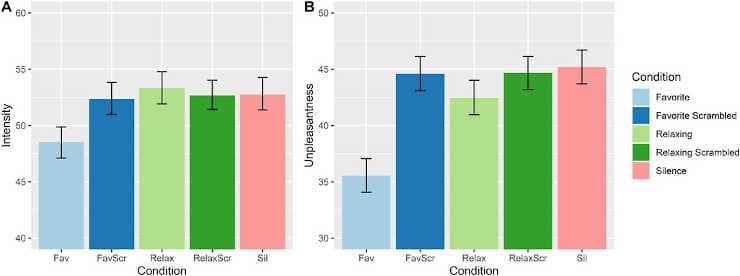Music can be a drug-free method of reducing our pain perception, according to previous research. This reduced sensitivity to pain, also referred to as hypoalgesia, can occur when there is a pause between the time that pain stimuli are received and the conscious mind recognizes them as pain.
A recent study by scientists in Montreal looked at the characteristics of music that most effectively reduce pain perception.
“In our study, we show that favorite music chosen by study participants has a much larger effect on acute thermal pain reduction than unfamiliar relaxing music. We also found that emotional responses play a very strong role in predicting whether music will have an effect on pain,”
said Darius Valevicius, a doctoral student at the Université de Montréal. The study, published in Frontiers in Pain Research, was conducted at McGill University’s Roy Pain Laboratory.
Tea and Scrambled Music
In order to determine which type of music reduced pain the most effectively, participants were subjected to thermal stimuli to the inner forearm that were moderately excruciating and produced a sensation comparable to holding a hot teacup against the skin. Each of the music excerpts that accompanied these stimuli lasted for an approximate duration of seven minutes.

Credit: Front. Pain Res. 4:1210572. doi: 10.3389/fpain.2023.1210572
With the sole stipulation that the tracks be a minimum of 3 minutes and 20 seconds in duration, the participants themselves chose their preferred music, which could originate from any source. The respondents were tasked with choosing two tracks to symbolize “their favorite piece of music of all time” and “the musical selections they would bring to a desert island.”
Compared to control tracks or silence, listening to their favorite music strongly reduced pain intensity and unpleasantness in participants. Unfamiliar relaxing tracks did not have the same effect.
“In addition, we used scrambled music, which mimics music in every way except its meaningful structure, and can therefore conclude that it is probably not just distraction or the presence of a sound stimulus that is causing the hypoalgesia,”
Valevicius explained.
Chill Out
Additionally, the investigators investigated whether musical themes could modulate the analgesic properties of preferred music. They designated the following themes to participant interviews regarding their emotional reactions to their favorite music: energizing/activating, joyful/cheerful, calming/relaxing, and moving/bittersweet.
The themed tracks were cut to a length of 6 m 40 s, which contained a transition from a medium level of arousal to a low level of arousal (“L-shape” of arousal). Before the main procedure, participants could select between 7 tracks and could listen to 20-s samples to help them make their decision. The tracks included were “Cotton Blues”, “Jamaicare”, “Légende Celtique”, “Musique de Film”, “Nuit Cubaine”, “Reggae Calédonien”, and “Sega Mizik Kèr”.
It was found that distinct emotional motifs exhibited variations in their capacity to alleviate pain.
“We found that reports of moving or bittersweet emotional experiences seem to result in lower ratings of pain unpleasantness, which was driven by more intense enjoyment of the music and more musical chills,”
Valevicius said.
While the precise nature of musical shivers remains unknown, they appear to be the result of a neurophysiological mechanism that effectively inhibits the transmission of pain signals. Chills may present themselves as goosebumps, a quivering sensation, or shivering in certain individuals.

Credit: Front. Pain Res. 4:1210572. doi: 10.3389/fpain.2023.1210572
The researchers also pointed to limitations of their study, one of which is concerned with how long participants listen to music samples. For example, listening to relaxing music for longer might have stronger effects than the shorter tracks the participants listened to in this study.
The researchers noted that additional research is necessary to determine whether listening to one’s favorite music also works well when combined with other non-thermal pain stimuli, such as mechanical stimulation or chronic pain.
“Especially when it comes to the emotion themes in favorite music like moving/bittersweet, we are exploring new dimensions of the psychology of music listening that have not been well-studied, especially in the context of pain relief. As a result, the data we have available is limited, although the preliminary results are fairly strong,”
Valevicius concluded.
Abstract:
Introduction: The hypoalgesic effect of music has long been established. However, the characteristics of music which are important for reducing pain have not been well-studied. Some research has compared subject-selected preferred music to unfamiliar music selected by researchers, and has typically found a superior effect from preferred music. In this study, we sought to discover what aspects of listeners’ relationship with their preferred music was important in producing a hypoalgesic effect.
Methods: We conducted a thermal pain and music listening experiment with 63 participants (14 male, 49 female, mean age = 21.3), in which music excerpts were paired with thermal stimulations. Pain ratings of intensity and unpleasantness, as well as emotional response variables, were rated on visual analog scales. We also conducted brief structured interviews about participants’ favorite music, on which we conducted thematic content analysis. Themes and emotion variables were analyzed for their effects on pain ratings.
Results: We first replicated the finding that favorite music outperforms experimenter-selected relaxing music in reducing pain unpleasantness (MD = −7.25, p < 0.001) and that the difference in hypoalgesia was partially mediated by an increase in musical chills (ab = −2.83, p < 0.01). We then conducted a theme analysis on the interview transcripts and produced four themes relating to emotional experience: moving/bittersweet, calming/relaxing, happy/cheerful, and energizing/activating. We found suggestive evidence that moving/bittersweet favorite music reduces pain unpleasantness through increased music pleasantness (ab = −5.48, p < 0.001) and more musical chills (ab = −0.57, p = 0.004).
Discussion: We find that music pleasantness and musical chills are salient predictors of music-induced hypoalgesia, and that different categories of favorite music derived from qualitative analysis may engage these emotional pathways to different degrees.
Reference:
- Valevicius D, Lépine Lopez A, Diushekeeva A, Lee AC and Roy M (2023) Emotional responses to favorite and relaxing music predict music-induced hypoalgesia. Front. Pain Res. 4:1210572. doi: 10.3389/fpain.2023.1210572
